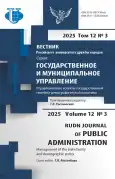The culture of men’s mindful attitude toward their health in the context of managing demographic processes
- Authors: Tanatova D.K.1, Korolev I.V.1
-
Affiliations:
- Russian State Social University
- Issue: Vol 12, No 3 (2025): MANAGEMENT OF THE STATE FAMILY AND DEMOGRAPHIC POLICY
- Pages: 341-349
- Section: MANAGEMENT OF THE STATE FAMILY AND DEMOGRAPHIC POLICY
- URL: https://bakhtiniada.ru/2312-8313/article/view/349658
- DOI: https://doi.org/10.22363/2312-8313-2025-12-3-341-349
- EDN: https://elibrary.ru/BVSGZY
- ID: 349658
Cite item
Abstract
On the basis of statistical material and sociological research, the authors demonstrate the crisis nature of demographic processes in Russia in general and focus in particular on men as a risk group for premature mortality. The analysis of demographic indicators shows that the continuing excess of mortality over the birth rate is due in no small part to the excess mortality of the male population of working age. It is noted that despite the difference in the biological resistance of the male and female organism, the reasons for the increased mortality of men lie not only in this difference, but also in their insufficiently formed culture of careful attitude to their health. The author’s sociological research, conducted among 6280 male respondents selected on the basis of a representative sample, reveals negative health practices in the life of Russian men and identifies stable patterns of men’s behavior that negatively affect their health. The study pays special attention to the analysis of socio-cultural determinants, which create significant barriers to seeking timely medical help. It concluded that Russian men pay insufficient attention to physical activity, tend to have unhealthy eating habits, are reluctant to undergo medical examinations, often fail to comply with treatment regimes and adopt a passive attitude to health issues. The study identified three dominant patterns of behavior in men’s attitudes to health issues: orientation towards the state health care system, emphasis on environmental factors and psychological stability, and emphasis on personal responsibility. The data show the prevalence of a passive attitude in which responsibility for health is delegated to medical institutions, which significantly reduces the effectiveness of preventive measures. The authors argue that it is necessary to apply health-building and health-enhancing technologies of demographic management to men. Special emphasis is placed on the development of specific communication strategies to overcome harmful stereotypes and to motivate men to adopt healthy lifestyles.
About the authors
Dina K. Tanatova
Russian State Social University
Email: dktanatova@mail.ru
ORCID iD: 0000-0002-7924-2242
SPIN-code: 7675-8938
Doctor of Sociological Sciences, Professor, Head of the Department of Sociology, Ethnography and Sociometry
4 Wilhelm Pik st., Moscow, 129226, Russian FederationIvan V. Korolev
Russian State Social University
Author for correspondence.
Email: iv_king@mail.ru
ORCID iD: 0000-0002-1317-2317
SPIN-code: 3585-2844
Candidate of Sociological Sciences, Associate Professor, Department of Sociology, Ethnography and Sociometry
4 Wilhelm Pik st., Moscow, 129226, Russian FederationReferences
- Minakov AV, Eriashvili ND. Demographic problems of socio-economic development of regions in the eastern part of Russia. Innovatsionnoe razvitie ehkonomiki. 2024;(1):87–94. (In Russ.). https://doi.org/10.51832/222379842024187 EDN: AKCEYI
- Sidorenko MYu. The management of demographic processes in the Russian Federation. Artificial Societies. 2023;18(3). (In Russ.). https://doi.org/10.18254/S207751800027230-2 EDN: NFVHVQ
- Oksuzyan A, Vaupel JW, Christensen K, Shkolnikov VM, Shkolnikova M. Sex differences in health and mortality in Moscow and Denmark. European Journal of Epidemiology. 2014;29(4):243–252. https://doi.org/10.1007/s10654-014-9893-4 EDN: UGPOIB
- Drapkina OM, Samorodskaya IV. Dynamics of regional mortality rates for men and women from diseases and external causes in Russia for the period 2016–2019 compared to 2020. Russian Journal of Preventive Medicine and Public Health. 2022;25(4):29–34. (In Russ.). https://doi.org/10.17116/profmed20222504129 EDN: GUYVCZ
- Beltrán-Sánchez H, Finch CE, Crimmins EM. Twentieth century surge of excess adult male mortality. Proceedings of The National Academy of Sciences of the United States of America. 2015;112(29):8993–8998. https://doi.org/10.1073/pnas.1421942112 EDN: UWFWMD
- Holden C. Why do women live longer than men? Science. 1987;238(4824):158–160. https://doi.org/10.1126/science.365990 EDN: IDXNON
- Zarulli V, Kashnitskya I, Vaupela JW. Death rates at specific life stages mold the sex gap in life expectancy. Proceedings of The National Academy of Sciences of the United States of America. 2021;118(20):e2010588118 https://doi.org/10.1073/pnas.2010588118 EDN: WADXNQ
- Goroshko NV, Patsala SV. Social factors of male mortality: Russia at the world background. Social & Labor Research. 2023;(4):81–96. (In Russ.). https://doi.org/10.34022/2658-3712 EDN: XWDBTG
- Ibragimova AA. Gender differences in life expectancy of the population of Tatarstan. Population. 2021;24(4):47–57. (In Russ.). https://doi.org/10.19181/population.2021.24.4.4 EDN: AQCTGA
- Lemish VV. System analysis of social perceptions of health in men at different stages of adulthood. Systems Psychology and Sociology. 2022;(1):30–47. (In Russ.). https://doi.org/10.25688/2223-6872.2022.41.1.3 EDN: QTCSIV
- Vergeles MO. Gender gap in life expectancy across high-income countries: more similarities or differences? Demographic Review. 2021;8(4):6–39. (In Russ.). https://doi.org/10.17323/demreview.v8i4.13874 EDN: INAYFA
Supplementary files










